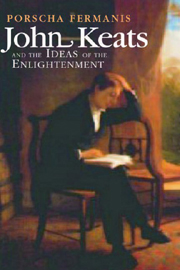Book contents
- Frontmatter
- Contents
- Acknowledgements
- Abbreviations
- Introduction: Keats, Enlightenment and Romanticism
- 1 Ancients and Moderns: Literary History and the ‘Grand March of Intellect’ in Keats's Letters and the 1817 Poems
- 2 Civil Society: Sentimental History and Enlightenment Socialisation in Endymion and The Eve of St. Agnes
- 3 The Science of Man: Anthropological Speculation and Stadial Theory in Hyperion
- 4 Political Economy: Commerce, Civic Tradition and the Luxury Debate in Isabella and Lamia
- 5 Moral Philosophy: Sympathetic Identification, Utility and the Natural History of Religion in The Fall of Hyperion
- Afterword: Ode to Psyche and Ode on a Grecian Urn
- Notes
- Bibliography
- Index
2 - Civil Society: Sentimental History and Enlightenment Socialisation in Endymion and The Eve of St. Agnes
Published online by Cambridge University Press: 12 September 2012
- Frontmatter
- Contents
- Acknowledgements
- Abbreviations
- Introduction: Keats, Enlightenment and Romanticism
- 1 Ancients and Moderns: Literary History and the ‘Grand March of Intellect’ in Keats's Letters and the 1817 Poems
- 2 Civil Society: Sentimental History and Enlightenment Socialisation in Endymion and The Eve of St. Agnes
- 3 The Science of Man: Anthropological Speculation and Stadial Theory in Hyperion
- 4 Political Economy: Commerce, Civic Tradition and the Luxury Debate in Isabella and Lamia
- 5 Moral Philosophy: Sympathetic Identification, Utility and the Natural History of Religion in The Fall of Hyperion
- Afterword: Ode to Psyche and Ode on a Grecian Urn
- Notes
- Bibliography
- Index
Summary
In Sleep and Poetry Keats asserts the voice of a ‘new school’ of poetry alluded to by Hunt in an 1816 article for the Examiner, in which he introduces three young poets (Shelley, Reynolds and Keats) and refers to a school ‘which promises to extinguish the French one that had prevailed among us since the time of Charles the 2d’ (1 December 1816, p. 716). The article appears after a long tirade on The Times and its support for ‘the right divine of kings to govern wrong’, lending by association an overtly political dimension to the article on the ‘Young Poets’: unlike the increasingly reactionary Lake School, the new school of poetry is conspicuously aligned with the constitutional reform movement. Keats may later contest Hunt's cheerful ‘sociability’ model with his own emerging emphasis on the importance of suffering and sorrow for creative development, but by criticising Restoration and contemporary poets alike in Sleep and Poetry1, he momentarily assumes the role attributed to him by Hunt: that of a young ‘Calidore’ attempting to bring down the reactionary Lake School and the conservative French School.
Greg Kucich has demonstrated that chivalry and the crusades are central to Keats's early self-definition, arguing that his allusions to himself as a crusading knight ‘embody his own “ambitious heat” as an aspiring boy-poet’. The aggressively asserted imagery of health, action and vigour in poems such as Specimen of an Induction to a Poem, Woman! when I behold thee and Calidore: A Fragment certainly defies contemporary reviews of the 1817 volume as well as later socio-stylistic readings of the poems, many of which are redolent with the language of sickness, disease and phobia.
- Type
- Chapter
- Information
- John Keats and the Ideas of the Enlightenment , pp. 39 - 64Publisher: Edinburgh University PressPrint publication year: 2009



